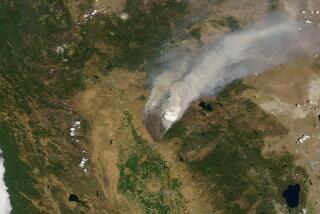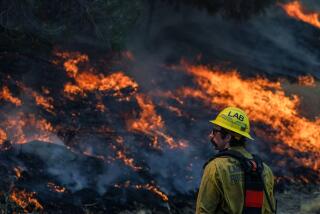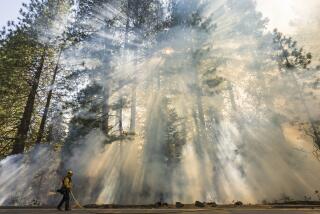Yosemite fire one of the largest in California history
GROVELAND, Calif. -- One of the largest wildfires in recent California history burned out of control in and around Yosemite National Park on Saturday, charring more than 125,000 acres, briefly threatening San Francisco’s power supply and frustrating firefighters’ efforts to contain it.
The fast-moving Rim fire has doubled in size since Thursday night and remains only 5% contained, with steep terrain, warm weather and low humidity hampering firefighting efforts. Adding to the difficulty is the blaze’s tendency to burn the tops of trees, creating a “crown fire” with long, intense flames that skip across forested land faster than a wildfire that creeps along near the ground.
Assisted by trench-digging bulldozers and water-dropping aircraft, more than 2,600 firefighters were battling the fire. Crews worked Saturday to keep the fire away from buildings at Camp Mather, just north of Highway 120.
“If you can’t stop a fire, you try to divert it,” said Cal Fire spokesman Johnny Miller. On Saturday, the fire jumped a trench cut by bulldozers three times, but firefighters and hot-shot crews were holding the line.
With temperatures in the upper-60s and continued low humidity, the fire’s march through rugged, hard-to-reach terrain remained virtually unchecked. Fire officials said no containment date had been set.
The fire has destroyed nine structures and threatened about 5,500 others since it erupted last Saturday. One firefighter suffered heat exhaustion, but no other injuries were reported.
Firefighters were able to gain containment of an area Saturday near the Hetch Hetchy water and power system, which supplies electricity and water for San Francisco. The San Francisco Public Utilities Commission has been forced to shut down two of its three hydroelectric power stations because of the fire.
Utility crews were allowed access to the stations to asses the damage, said Michael Carlin, a deputy general manager with the commission.
On Friday, Gov. Jerry Brown had extended a state of emergency to include the city and county of San Francisco because of the threat to Yosemite-based utilities that supply power and water to San Francisco. The commission has purchased power on the open market and has seen only a slight dip in production as a result of the fire, he said.
American Red Cross spokesman Jordan Scott said that on Thursday, 102 evacuees stayed at the evacuation center set up at the Mother Lode Fairgrounds in Sonora. The center has a 1,000-person capacity.
“The general rule is you get about 10% of the number evacuated,” he said. “I don’t know whether we’ll hit that 10%.”
He said that because many of the houses under evacuation advisories are vacation homes -- combined with the fact that residents are no strangers to wildfires -- many already have contingency plans in place.
Larry Brown, who was volunteering for the Tuolumne County Sheriff’s Department, said the Rim fire was “coming in at a close second” to a rash of wildfires that scorched hundreds of thousands of acres throughout the state in 1987.
Four firefighters died battling those blazes, including one crushed by a falling tree in the Stanislaus National Forest. Tuolumne County was among the areas hit hardest.
Because the fire is confined to the park’s more remote northwestern section, campers in the Yosemite Valley have been largely unaffected, park ranger and spokesman Scott Gediman said.
“It’s 20 miles from the Yosemite Valley,” Gediman said. “It’s still beautiful skies and very little smoke impact to Yosemite Valley and the park.”
ALSO:
Interactive: Rim fire near Yosemite
Raging Rim fire crosses into Yosemite National Park
Former assemblyman files papers to fill Bob Filner’s mayoral seat
Marcum reported from Groveland and Streeter from Los Angeles. Stephen Ceasar contributed to this report.
More to Read
Sign up for Essential California
The most important California stories and recommendations in your inbox every morning.
You may occasionally receive promotional content from the Los Angeles Times.












